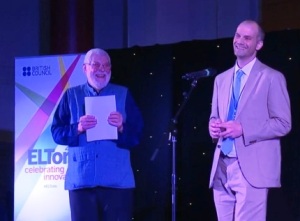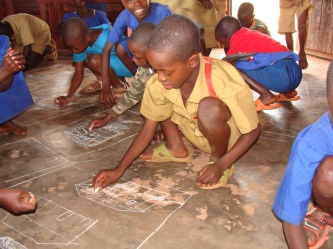On 2 June 2016, Teaching English in Africa (TEIA) won the British Council Elton award for Local Innovation, after being shortlisted earlier in the year along five other resources in the category including video and online resources, learner libraries, and large publishing companies such as Oxford University Press and Macmillan Education. It was up against some excellent competition, but I suspected that it was in with a chance upon reading the judges’ comments in the brochure. The comment selected for TEIA was very positive:

“A unique, comprehensive resource for a previously neglected context of English teaching.”
Sure enough, when that dreaded heart-wrenching moment arrived, I was surprised and overjoyed to hear the presenter say those magic words:
“The British Council Elton for local innovation goes to Teaching English in Africa…”
Since receiving the award, I’ve received a lot of requests for more information about what’s in the book, how it came about, and the contexts for which it is written. So here we go…
What are the current realities for African English teachers?
Africa is of course many contexts, especially with regard to education. Significant differences often exist between rural and urban schools within the same country. Yet while there is so much cultural, social and linguistic diversity in Africa, the socio-economic challenges that many countries face in trying to meet the millennium development goals and reach 100% enrolment have led to similar challenges in many classrooms across the continent (see Clemens 2005). These teaching realities may include very large classes (sometimes over 100), a lack of teaching and learning resources, inadequate preservice training for new teachers, and the challenge of trying to teach English literacy in primary school to children who are still having difficulty learning to read and write in their mother tongue. TEIA aims to provide support to teachers working in the most challenging of these contexts, those that are so often neglected by the mainstream methodological literature.
How did the book originate?

TEIA has been nearly 10 years in the making, and has drawn on the best practice of African teachers and teacher trainers who I have had the privilege to work with across the continent – initially for VSO, and later for UNICEF and national ministries of education. I first travelled to Africa to work for VSO Eritrea as an English methodology trainer in Adi Keih in the Debub Zone of the country in 2007. I found myself working in a rural context of the type common across sub-Saharan Africa. Students were in schools and teachers were teaching, but I noticed significant differences between the quality of teaching of the more experienced teachers (often in the local town) and the newly appointed teachers (often in remote locations). Drawing on both my previous teacher training experience and my VSO training, I began to build links and explore ways to support and improve the local professional development network that existed. While I was able to contribute a small number of useful ideas and strategies at CPD meetings, I felt that the biggest potential gains could be made from getting the more effective teachers to work in small mentor groups with the newly qualified ones. We introduced some new ideas, such as ‘Teaching Buddies’ and nonsupervisory lesson observations that helped to facilitate this process more effectively. During my two years in Eritrea, my learning was exponential, both from my own classroom (I had insisted on teaching for much of this time, as well as training), and from my work with inspirational colleagues and teacher training supervisors.
I went directly to a second VSO placement in Rwanda, where I had an opportunity to work with just a small number of schools (4), this time at primary level, and with teachers of all subjects. Despite the 2000 km between these two locations, and the differences in language, culture and history, I was surprised to find a lot of similarities in the challenges that teachers faced, and consequently the teaching practices that had evolved. I found that much of what I had learned in Eritrea was useful in Rwanda – indeed, much more than my previous years of experience working as a teacher and trainer in Europe. I also noticed a similar gap between the more and less capable teachers that became a focus of the teacher development programme that we set up at the four schools. I was still in contact with my old colleagues in Eritrea, and found opportunities to share innovative ideas from the Rwandan teachers with the Eritrean ones. It was at this time that one of the headteachers suggested it would be a good idea to put together a booklet of lesson plans that drew on expertise from both contexts. This was the starting point from which the book itself would gradually develop.
In Rwanda, there were also opportunities to work on national projects. The country was switching from French to English-medium education, and I found myself involved in curriculum development projects, nationwide English language training projects for teachers, and even some work on the UNICEF Child-friendly Schools project that was to lead into my future consultancy career. While working with both Rwandan and Ugandan English language teacher trainers, I had often noticed them making use of practical guides such as Harmer’s The Practice of English Language Teaching, a good book, but one written for a very different world, and promoting methodology that has never been demonstrated to work in African primary and secondary contexts. It occurred to me then that a guide that drew on African expertise, described it and expanded upon it within the constraints that such teachers experience would be significantly more useful for these teacher trainers and their teachers.
Subsequent opportunities to work in several other countries in East Africa, southern Africa and North Africa provided opportunities to notice and compare contexts, and to recognise commonalities, most often as a result of the socio-economic challenges faced. During a UNICEF project in Kenya, I met a member of the East African Educational Publishers (EAEP) team (based in Nairobi), who suggested a potential collaboration. Kiarie Kamau and Jane Mathenge at EAEP were enthusiastic about the initial proposal, and with the excellent help of Benson Shiholo as copy editor and Dr. Lilian Kaviti as content editor, the book was written. Abdul Gugu drew the illustrations.
What’s in the book?
The book is divided into three sections: Part A – Key Concepts; Part B – Literacy; Part C – Teaching Practice. ‘Part A – Key Concepts’ focuses on principles of good teaching within the African classroom, presenting a model of child-centred English language learning developed in Africa, using the acronym CHILD to help readers remember five key principles as follows:
C – Children COMMUNICATE with each other
H – Children HELP each other to learn
I – Children IDENTIFY with the lesson content
L – Children LEARN at their own speed
D – Children DEMONSTRATE what they have learnt
‘Part B – Literacy’ focuses on initial literacy in English in the primary classroom, whether this happens alongside mother tongue, after it, or in the unfortunate case where children have to learn English as their first language of literacy. It presents a model of synthetic phonics that is Africa-appropriate, avoiding references to objects that children may not see in Africa, and never assuming that children have more than the bare minimum of English language knowledge.

‘Part C – Teaching Practice’ focuses more on teaching in upper primary and secondary contexts, presenting effective example lesson plans from teachers in different countries, ideas for activities and games that require no additional resources, and a model of CLIL based on the practices of effective sciences and humanities teachers in Africa who recognised that teaching in English often means also collaborating closely with English language teachers for the sake of the learners. The book also presents 10 essential resources for effective English language teaching that all African teachers can make themselves, and helps teachers explore the effective use of the mother tongue in the English language classroom, something I believe strongly in, because this is one of the few resources that most (but not all) African teachers share with their learners.
The book recognises that many readers may only have intermediate levels of English or lower, so any new terminology is highlighted and explained at the back of the book, and the English used is clear and simple, avoiding clause subordination and passive voice wherever possible. In short, it contains everything I have learnt from the many talented African teachers I’ve worked with, and a few ideas of my own. Sections of the book can be previewed on Google Books or the African Books Collective website.
Only a first step
I’m aware of the irony of a European writing this book for African teachers (see, e.g. Phillipson, 1992; Holliday, 1994), something I readily acknowledged in my acceptance speech (see below). Because of my privileged status as an expat trainer, and especially thanks to the opportunities provided by VSO and UNICEF, over the last nine years I have been able to work in a wide range of different African contexts, both longitudinally at classroom level with the teachers themselves, and also with experienced methodologists, materials writers and consultants. This combination is something that few teacher trainers, researchers, or consultants ever get the opportunity to experience. While some may argue that such a book is premature, and that the advice is based on personal practical knowledge rather than evidence, I believe it would be a greater injustice not to share the benefit of my experience, given how little appropriate methodological literature is available for primary and secondary teachers in Africa. As I also mentioned in my acceptance speech, this book is only an initial attempt to provide something in the way of support to those (especially preservice and novice teachers) who are most in need of it. I hope that within this remit, it will be of some use. The judges seemed to agree. Many thanks to them and to the British Council for the award.
Good work! Congratulations!
LikeLike
Many thanks Shaun.
LikeLike
i can’t wait to read it
LikeLike
Thanks Riham – I have a copy I can lend you!
LikeLike